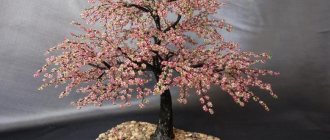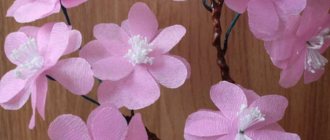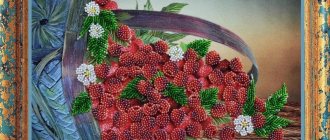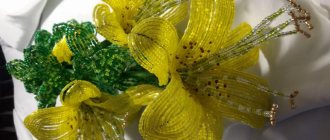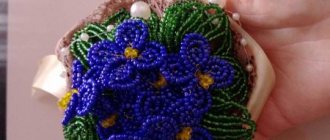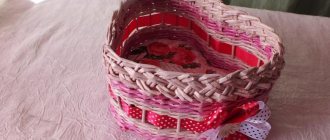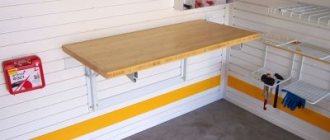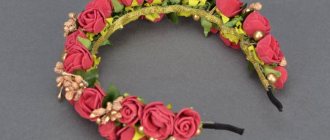A beaded orchid will take its rightful place in the design of almost any apartment. You cannot pass by this sparkling exotic flower indifferently.
At the same time, it is easy to work with and can be made independently. It is enough to select the necessary materials and carefully study master classes on working with beads.
Materials
To do this, you should ensure that you have:
- beads of desired colors;
- pearl beads in the amount of 6 pieces - 10 mm, 7 pieces - 6 mm;
- wire 0.3-0.4 mm;
- floss thread;
- gypsum;
- Moment glue;
- rulers;
- pliers, wire cutters;
- pot;
- small decorative items.
All materials are not expensive or rare; they can be found in every home or store nearby.
Making an orchid with your own hands
Exotic flowers made from beads have another undoubted advantage - they do not need care, do not get sick and do not fade.
A very important point that needs to be decided in advance is the selection of material. For a beginner, inexpensive Chinese beads are enough to get the hang of it. But to make the flower look better, you will have to spend money on a good Czech one.
Required materials and tools
This orchid is called Phalaenopsis and is rightfully considered one of the most popular among gardeners.
To make this greenhouse miracle you will need:
- colored beads;
- 7 pieces of pearl beads with a diameter of 6 mm;
- 6 pieces of beads with a diameter of 10 mm;
- wire with a diameter of 0.3-0.4 mm, 1 mm, 1.5 mm;
- 2 pieces of floss thread;
- gypsum;
- glue "Moment";
- ruler;
- pliers and wire cutters;
- pot;
- small decorative items.
Thin wire with a diameter of 0.3-0.4 mm is needed in different colors: silver, golden, green and red. Thick is desirable in green.
You can choose the colors of the beads for the inflorescences at your discretion.
To make it easier for beginners to navigate, it is better to buy:
- 100 g green (different shades);
- 50 g white;
- 10 g yellow;
- 20 g red (transparent and opaque);
- 30 g of pink (shades of varying degrees of intensity are selected).
Once all the materials are available and at hand, you can begin to work.
Weaving pattern
Beaded orchids consist of a number of elements, the weaving patterns of which are shown in the master class. These are buds of different sizes, flowers and leaves. They are made one by one.
There are several ways to knit a craft that will delight its owners for a long time. One of the simplest is “French weaving” or “arcs”. Mastering this method according to the scheme does not require much effort. All parts will be made by him, the difference is only in the number of arcs and beads.
You just need to understand that the central thread is the axis. And the second end is called the “working” end.
Leaves
You need to make 10 leaves. Of these, 4 are small with an axis of 7 cm (this is exactly the number of beads you need to collect) and six arcs, 3 medium ones with an axis of 9 cm and six arcs, 3 large with an axis of 9 cm and seven arcs.
Sheet manufacturing method
Step 1. Take a wire with a diameter of 1 mm and cut a piece of 20 cm from it. This is the axis. A ring is made at its end using round teeth; this will not allow the beads to come off the base. In this way we make twigs for all sheets.
Step 2. String the required amount of beads onto each of them. A ring is also made at the second end of the twigs. The axles are ready.
Step 3. Take the end of a wire with a diameter of 0.3 mm and put all the beads remaining from the axes onto it. For a small sheet it will take about 1.5 meters, and for a large one - about 2 meters.
Step 3. Making a small leaf. 2 pieces of 12 cm each are cut from a thin green wire. This is for the upcoming stitching of leaves in width.
Step 4. Take the axis prepared for the small sheet. The end of the working wire is placed on the axis at a right angle and wound with small twists. A bead equal to the sheet is moved along the working end, and 1 turn is made upward around it. Then another one down to the fastening coils. The first row is completed.
Step 5. Using thin wires for stitching, the resulting sheet is mentally divided into three parts. It’s better to make the middle one a little larger.
Step 6. The wires are fastened with one turn around the axis. Then each of the arcs moves closer to the central part, and a second turn is made, this time capturing them. The rotation of the fasteners goes down. This will create the front (where the wire is almost invisible) and the back part of the leaves. Firmware is necessary - it makes the fabric more dense and textured. Thanks to it, the sheet does not “spread” in all directions and maintains its original shape.
Step 7. The required number of arches are made, each one is immediately stitched. On the last row of stitching, the wire needs to be hidden. To do this, the arc beads are first moved back and a turn of the firmware is made along the bare wire of 0.4 mm. Then the tail of the stitching is applied to the working wire and the beads are pushed onto both of them. This way you can hide the extra ends. If they are too long, you can trim them slightly.
To hide the ring above the sheet, you need to loosen it a little and move the woven fabric so that it hides it. Then the ring closes again. It remains from the inside of the product.
The remaining leaves need to be woven in a similar manner. To make the composition more lively, you can take several shades of green for work, dilute it with yellow or light green.
Small green bud
For small green buds, a wire of 0.3-0.4 mm will be used. For one bud you need to make 2 round blanks.
Step 1. A loop is twisted from the working wire. The length of the ends is approximately 5-7 cm. 3 green bugles are strung on the axis. Two pairs of arches are made. The working wire is cut.
Step 2. The second blank is made in the same way. A bead with a diameter of 10 mm is put on both axes. This will be the middle of the bud.
Step 3. The sheets must be made convex so that the reverse is hidden inside and they wrap around the bead. The axes twist together. Three such buds are required for the composition.
Large multi-colored bud
Large buds are woven from beads of several colors. Each consists of three leaves with 5 beads on the axis. Three pairs of arcs are made.
The color is selected at the discretion of the master, but the more green there is from the base, the more “immature” it is. Then, when composing the composition, they are placed higher. If the detail is in bright colors, then it is placed lower, simulating that the flower is about to bloom.
Step 1. Weaving three colored petal blanks.
Step 2. The finished petals are folded on top of each other, and their axes are twisted. The petals are straightened with the wrong side inward. Outwardly it looks like a trefoil. The twisted axes are pulled upward.
Step 3. Using the fingers of your left hand, press the parts together as tightly as possible, and with your right hand, using pliers, screw the axle to the very base of the part. The petals are given a convex shape, and a large bead (diameter 10 mm) is placed on the axis.
Step 4. The bud is assembled. All wires are twisted together. For more reliable fastening, the threads at the base are twisted with round pliers.
It is very important to pay attention to the fact that the finished part should not have a gap between the petals. The bud should look tightly compressed.
Large colored buds are made in triplicate.
Stamen
Three elements are prepared for the stamen. This is a pestle, or column, and 2 round “ears”.
For this work, yellow beads and wire of the same color are used. You will also need pearl balls.
Step 1. 26 yellow beads and one large one (diameter 6 mm) are strung on a wire.
Step 2. An indent of 6 cm is made from the edge of the metal thread. Then it is bent in a cross on both sides under the “pearl”. To fix its position, 1-2 turns are made.
Step 3. The short end of the wire is applied to the long one and 5 small ones are moved under the large bead. Both ends of the wire must pass through them.
Step 4. Now an element is made that hangs over the “pearl”. To do this, another 21 pieces of glass are moved closely (being on only one fishing line) to the previous element and this segment with the decor must be folded in half. The resulting column is fixed with 1-2 turns.
Step 5. The wires are twisted and the long part is trimmed.
Step 6. “Ears” are made for the side framing. The free end is measured at 6 cm, 4 beads are moved and a couple of turns are made under them.
You need to make another one above this loop. To do this, 13 parts are moved, they are wrapped around the top of the first element, and the structure is secured again. Both tails are curled together.
It is necessary to make 7 pestles and 14 “ears”.
Flowers
The opened phalaenopsis flower will be assembled. It consists of 3 round petals (petals), a lower one, or lip (also called “tongue”), 2 sharp petals (sepalia) and a stamen.
Step 1. First, round petals are made. To make them, thin silver wire and white beads are used. From the side of the loop, an axle 7-9 cm long is taken, about 2 cm is allocated for twisting. 6 beads are strung on the axle.
Step 2. The required number of beads (8 pcs) are strung on the working thread and 1 turn is made around the axis at a right angle. If you follow this technique, the part will turn out round. Then the step is repeated (9 pieces of beads), the first row is completed. There should be five arcs in total. For each row, the required number of white parts is added.
Step 3. The free part of the axis is masked. It is folded onto the wrong side of the sheet and pulled through the axial glass bead in the opposite direction. To make it tighter, tighten it with round nose pliers. The excess is cut off.
Step 4. For the sepal, or sharp petal, you need red or pink beads in different shades. It needs to be mixed and then collected in a row, in random order. For work, use a thin red wire. To make the base, 8 beads are strung onto the axis.
Step 5. To make the petal sharp, you can use a little trick. When making the first arc, the first row is made with 11 and 12 beads, and then another additional bead is pulled on top of this arc onto the axis. This is done two more times. There are 4 rows in total, between which 3 additional parts on the axis form a sharp tip.
Step 6. At the end of weaving, the working wire is secured at the base with a twist. The excess is cut off. It is necessary to mask the axis. But it will be difficult to do this by pulling through the axial beads due to the additional details. Therefore, proceed as follows: the axial thread is hidden in one or two additional beads, tightened, and the excess is cut off.
Step 7. For the “tongue”, take red beads of two shades and thin wire to match. One bead is transparent and the other is not; before work, they are mixed in a cup. Then this bright element will look beautiful in the sun. Three beads are strung on the axis, an arc is made of 5 and 6 beads. Both axles, upper and lower, bend upward. This is required to immediately weave the lip into a rounded, concave shape.
Step 8. The second row is laid unevenly, slightly higher and slightly wider than the previous one.
Step 9. The third and fourth arcs are formed using the same principle. The petal takes on the appearance of a deep spoon. The working thread is wrapped around the base with 6-7 turns, and it is cut off. The axial one is masked, extending into the central beads.
There should be seven flowers in total. Accordingly, it is necessary to make 21 white round petals, 14 sharp ones, 7 “tongues”.
Step 10. You need to pair the white and sharp petals. For each flower you will need two of these parts. After all the elements are prepared, you can harvest the plant.
Assembling the orchid and creating the base
You can assemble the plant when all the parts are made. It all starts with the smallest thing - with the pestle.
The “tongue” and pestle are twisted. The pearl should rise directly above the “spoon”. Twist length - 1 cm.
Ears are placed on the sides, they are attached to the pestle and then bent to the side. All the details frame the pearl with its front side.
One white leaf is placed above the core.
The resulting structure is combined with previously prepared “white and sharp petal” pairs. They are screwed so that they extend in front of the central white element.
The flower is collected. All elements need to be aligned, the round ones need to be slightly bent inwards, the sharp ones bent at the ends, the core straightens out.
Before assembling the plant, its parts need to be given as natural a look as possible. For this, pieces of green floss thread are used.
You need to start with the stems of the leaves. The length of the thread winding is 1.5 cm from the root of the leaf. The thread is pressed tightly to the sheet, a drop of glue is applied to the base and turns are carefully made in one place (several for fastening). Then it is wrapped to the required distance and glue is applied again at the end.
Almost all the parts are wrapped this way, except for two small buds.
Assembly of branches
For ease of work, all the blanks for the future composition are folded the way they will look in the future. Then the assembly of the entire plant begins.
Instructions for assembling an orchid branch:
- The upper small bud is slightly wrapped with thread around the trunk, then applied to a thick wire for the stem. First, it is screwed on with turns of wire, then coated with glue and wrapped with thread until the next element is attached.
- After the buds comes the turn of the flowers. But we must take into account that the structure already weighs a lot and can bend under its own weight. Therefore, it is worth adding another steel rod to the stem. So that it does not catch the eye, it must be attached from the inside out.
- To make the orchid look natural, the trunk must be slightly bent in different directions. This can be done by holding any picture of the finished plant before your eyes.
- After all the parts are secured to the branch, the stem is wrapped about another 15 centimeters.
- Several smaller leaves are attached to the trunk. Then come the big leaves. The end of the branch is tightly wrapped with threads.
After completing the assembly of the branches, their “roots” are bent in different directions so that it stands securely in the pot. Now the plant is ready for planting.
How to make a stand
It is required to make a “soil”.
Preparation of gypsum solution:
- 0.6-0.7 liters of cold water is poured into the container.
- 250 g of dry gypsum is poured into the water. The solution must be stirred constantly to prevent the formation of lumps.
- The mixture is left for 1-2 minutes.
The prepared solution is poured into the pot. When it takes up 2/3 of its height, orchids are installed there. Now it is necessary for the structure to dry. To do this, leave her alone for a day.
The stand of the finished bead composition is decorated with pieces of bark or moss, which will hide the gypsum filler.
Beads
For flowers, you can use beads made in China, but Czech beads look better due to the same size of beads. Before weaving, the material must be checked for abrasion and exposure to sunlight. If the beads survive rubbing and soaking in water, then they can be safely used.
Sometimes Japanese beads are used, but weaving requires a large amount of material, and it is not cheap.
Beautiful plants will come out of gasoline, brocade, and pearl beads. It is better to buy in reserve, because you will have to postpone the work until it is found.
Video lesson:
Blue orchid
To make a blue orchid, we will need dark and light blue beads, green, orange and yellow, green, gold and silver wire, thick wire for the stems, threads, glue and plasticine. Weaving is done in the French style.
The instructor talks in detail about all stages of work: by repeating the movements, you can hone them to the point of automaticity. The five blue petals of the flower are different, and each requires a different number of beads. The stamen is made of yellow beads; a yellow bead is fixed in the center. All parts of the flower are connected to each other.
Wire
You can purchase it at craft stores or use copper wire from electrical wires, after cleaning it.
The main thing is that the diameter allows you to pass through the beads many times, and for this you should take into account the size. If you plan to use 10, then you need a thin one, if 8 or 6, then the wire can be thicker.
Material selection
Before you start crafting, it is worth purchasing high-quality materials so that the work proceeds easily and simply, and the finished craft does not deform over time and does not lose color.
Modern technologies for the production of beads from glass and plastic have allowed manufacturers to send to the market a large number of different types of beads, of all kinds of colors and sizes. Thanks to the wide range of similar products in handicraft stores, craftswomen have the opportunity to select high-quality materials and create products for every taste.
Beads of three main forms are most often used in work:
- Regular beads are small square and round beads with melted edges.
- Cutting - short tubular beads 2 mm in length, with chopped edges.
- Bugles are elongated tubes 3-25 mm long, having a round, twisted or faceted shape.
Today you can find beads of different sizes, which are indicated by special numbers.
Each material is assigned a specific number, it shows how many of these beads are required to, when laid out in one row, make a line one inch long. So, to create such a segment you need to take 6 beads of size 6/0 or 10 beads numbered 10/0. Knowing the number of the required material, you can calculate its approximate amount in a regular 10-gram package. For example, there will be about 2 thousand Czech beads No. 12/0 in such a bag, and beads No. 10/0 - only 800-850.
Taiwanese and Chinese
The most inexpensive beads are brought from India, China and Taiwan, but they are not of good quality and are made of plastic. Beads from the same package may differ from each other in shape, size, and may also have chips and unevenness. Because of their fragility, they often break during work and even in the finished product, so experienced craftswomen prefer to bypass Chinese material and purchase more expensive raw materials.
Cutting and bugles from China usually have poorly finished sharp edges near the holes, which can damage the thread on which they are picked. In bags with Indian raw materials, beads are occasionally found without one hole or without them at all.
The materials from these manufacturers cannot boast a wide range of colors. Most of them have silver-plated holes and are made of opaque or transparent plastic. Unfortunately, Chinese beads have an unstable color, so they noticeably peel off during needlework.
Such beads are usually chosen by beginning needlewomen to practice before performing complex crafts, or for children's creativity.
Czech beads
Today, products from Czech manufacturers are especially popular among experienced and beginning craftswomen. It is of much higher quality than beads from India and China, and can also please you with a large assortment. Materials from the Czech Republic come in a variety of sizes, shapes and colors.
Small decorative elements
In order to cover the plaster, glass pebbles, beads, and sea pebbles are useful. Butterflies and ladybugs are used, which can be planted on leaves.
Note!
- DIY beaded chamomile step by step - easy instructions with photos and descriptions
Sakura from beads - a step-by-step description of making beautiful Japanese trees with your own hands (100 photos)
- Beautiful butterfly made of beads: photos, instructions and patterns for weaving a beautiful beaded decoration
How to weave
An orchid is made using French weaving. It consists of putting a certain number of beads on a piece of wire, and then making an arc. Therefore, the technique is called arc.
Weaving different petals and leaves involves using a standard method; it differs slightly for different species.
Necessary calculations
It is almost impossible to calculate the required amount of beads for a product. What complicates the situation is that the grams are written on the packaging, but in all diagrams the number is indicated individually. To help the craftswomen, they created several auxiliary tools, formulas, diagrams and applications.
The easiest way is to check in the table. For each manufacturer you can find a table where the beads are indicated in a ratio of 100:1. Let's look at the example of Czech.
Everything you need to know to use this method:
- bead manufacturer;
- weaving method;
- dimensions of the future product.
Round leaf
The master class will help you make such a leaf without much difficulty. It is important to follow the procedure:
- Take a piece of wire of the required diameter of about 70 cm.
- Make a loop.
- String 5 beads onto the free end.
- Secure the string with a small loop.
- For the remaining segment, enough beads are collected so that only 5 cm of unfilled material remains.
- 7 beads are strung on the arc on the right side.
- Wrap around the axis.
- Form a meadow on the left side.
- It is necessary to make 6 arcs on each side to make a leaf.
Making leaves
Since the leaves are large and very heavy, it is better to weave them using parallel weaving (Fig. 10a, b).
In total you need to make five to six leaves. Each sheet consists of two parts, with a strip of two dark green beads running down the center. The first row is made of five beads. In each next row we add two beads until there are twenty beads. Twenty beads is the middle. From the middle we begin to decrease in the same order as we added. Using the diagram in Figure 106, we weave the second symmetrical first half of the sheet. We connect the stem of the leaf to the stem and wrap it with green thread for six to seven centimeters.
Serrated petal
Beautiful, but difficult to create.
- Start weaving like a leaf with a sharp tip.
- A right return arc is performed, that is, it is fixed on top of the previous arc, retreating 5-9 beads from the top edge. The wire is inserted from the inside out and brought out onto the face.
- Fix the arc from below, the second half bends around for a tight fit.
- The arc is returned from the left side, as well as from the right, and the fastening of the first half of the arc should be at the same level, the first part of the arc as the right.
- The completion of the arc on the left is similar to the one on the right.
- The arc going to the right is fixed to the previous one.
- The left one weaves the same way.
- Make the required number of arcs. For final fixation, the wire is twisted around the rod.
- Bend the end of the axle going from above inside out, cut it to the top bead, pressing it tightly against the axle.
- The leaf is ready.
Video lesson:
Golden white orchid
Orchid petals have different sizes, so for each flower you will need to weave three oblong petals and two round petals. The oblong ones are made around an axis with 12 white beads, around which six arcs are formed. In the center of the round petals there are three beads, around which seven turns must be made.
The middle part of the orchid is knitted from golden beads and consists of three small petals. These petals curl together and join the lower, white petals. The finished flowers are attached to a wire that acts as a stem.
Preparation Tips
- Beads for the product can be of any color;
- The accuracy of the product depends on the quality and size of the source material;
- The wire is matched to the shades of colors. For light ones, silver wire is needed. Dark ones require copper or colored ones.
- For the base of the flower stem, you need a wire rod (1.5 mm or more) or a tree branch. You don't have to worry about the color; the trunk will be covered with floral tape.
- A large number of beads affects the weight of the product, so that they do not bend; a large diameter wire (1 mm) is used as an axis.
- Working with beads affects vision, so a well-lit work area is necessary for preservation. The beads are placed in containers or boxes.
Orchids using mosaic weaving technique
Mosaic weaving is one of the most popular among bead artists. Many schemes have been developed for it. The canvas made using this technique is very dense and looks attractive.
But it is not recommended for beginners to take on a large composition using this technique, as it is quite labor-intensive. First, you should get your hands on simpler things and master the options for volumetric weaving.
For work you will additionally need the following material:
- thick white thread (nylon or lavsan);
- scissors;
- fishing line;
- needle;
- lighter.
A lighter is used to singe the threads and fishing line after fastening to give them additional strength.
Weaving pattern and assembly
Weaving work should be carried out based on prepared patterns.
Technique for making a flower:
- According to diagram No. 1, three narrow-shaped petals are made step by step. 10 beads are strung with oblique mosaic weaving.
- The first half of the flower is woven, then the second. To combine them, you need to walk through the center through small glass beads.
- In this case, additional details are introduced.
- Return. After which the petal contracts quite strongly. This is done so that the surface becomes embossed.
- Sewing parts.
- According to diagram No. 3, 14 beads are strung. 3 wide-shaped petals are woven. The edges are braided according to the pattern.
- One wide piece is rolled into a tube. It is sewn at the edges.
- Pistils are made. This is done by simply stringing beads. The result is pendants that are attached to the middle.
- Among the narrow parts, it is necessary to sew wide ones.
The initial set of bugles forms the width of the petal. And the length depends on the number of turns. When working, you should carefully monitor the proportions.
Orchid flowers will turn out very delicate and natural. They can be used in any composition.
The rest of the flowers, leaves and buds are made in the same way. Leaves can be made using a simpler technique in arcs.
All that remains is to collect the flower and secure it in the flowerpot.
White and pink orchid
To own a pink and white beauty that can liven up your interior, you should take care of the following accessories:
- beads of green, white, pink, yellow, red shades;
- large beads, 5-6 mm and 10 mm in diameter;
- tea tape or floss threads for decorating the trunk;
- wires 0.3 mm, 1 mm, 1.5 mm;
- plaster or alabaster;
- a pot for planting a flower;
- glue;
- sea, glass pebbles, beads for soil;
- round pliers, side cutters;
- rulers;
- containers for mixing gypsum.
Video lesson:
Homemade orchid
The video shows in detail how you can create a beautiful beaded orchid with your own hands. We start knitting with long green leaves. Each of them is formed from several wires on which green beads are placed. Flower petals are formed from pink beads.
The three petals are twisted together, after which the two upper petals and the middle are attached to them, the base of which is a larger yellow bead. The pink petals also form flower buds. The wire where the flowers are attached can be wrapped with green tape. Buds and blooming flowers look natural.
Leaves
Plant parts can be large, medium, small. To create them:
Wire with a diameter of 1 mm is cut into twenty-centimeter pieces. The number is equal to the number of leaves.
Create a loop at one of the ends, and place the required number of beads on the resulting central part.
Wire 0.3. mm is filled with all the beads that are needed for weaving. To maintain the shape, they use firmware; for this, two pieces of wire are made, the length is 20-22 cm.
The tail of the acting wire is screwed to the axial element. Move in the required number of beads. Carry out the first longitudinal row, turning the axis of the leaf once using a top-down movement, bringing the beads closer to form the second half of the 1st row. Where the base of the sheet is, wrap the wire around the axial center.
From the inside, two pieces of wire are placed perpendicular to the axial part to secure the rows.
The first and subsequent rows are fixed using one turn of wire from the top down. So the firmware becomes invisible. Next, weave the required number of rows: large leaves - 7, medium - 6, small - 5.
In the row, which is the final one, the stitching wire is masked using this method: the beads are moved at the stitching point, one turn of the wire is made, which serves for stitching before the current one, they are connected, and the next number of beads is moved forward by two sections at the same time.
The axial element is shifted in such a way as to mask the loop from the inside. They relax it a little, move the axial part, and compress it again. The active wire is fixed to the axis using a winding and removed.
The remaining leaves are created in a similar way.
Buds and leaves
The beading pattern of an orchid is determined by the structure of the living plant. Since in addition to the opened flowers there are buds and leaves, you need to make preparations for them as well.
Unopened flowers are made from four elements. The central element remains the stamen, which is surrounded by three petals, made in a similar pattern. The colors are distributed as follows: the middle is pink and the edges are white.
The leaves located at the bottom of the plant can be made by cutting them out of tape. Or, like flowers, made from white. In this case, the following scheme can be used:
- The wire is cut into pieces of 20 cm;
- A loop is made at the end of the cut;
- Beads are collected for the axle;
- The end of the working wire is screwed to the side opposite the loop;
- Beads are collected on it, which form rows around the axial one.
To keep the sheet in shape, firmware is used.
Stamens
- For the stamens, 1 large pearl bead and 25 yellow beads are collected onto the existing wire tail.
- One piece of wire about 6 cm is left unoccupied. The pearl is attached in the middle with a twist.
- They fasten both segments and move 5 beads closer.
- They move the beads that remain in the amount of 21 beads and form a loop - a pestle.
- Both segments are twisted together.
- Two ears are performed. 4 yellow beads are collected onto the wire, fastened into a ring, and another 1 circle is made around the loop in the center, twisting both tails.
Composition and color palette
Orchids look very magical and decorate every home with their appearance.
The color palette of these plants is multifaceted, and they consist of:
- brushes with flowers;
- delicate flowers;
- sepals;
- curved stem;
- pointed leaves.
This flower is very symbolic; it is customary to give it to loved ones. According to ancient traditions, each type carries its own secret meaning.
We suggest you understand this a little before starting production:
- a white beaded orchid will symbolize pure love in your home;
- motley - strong passion and desire;
- dark red flowers will fuel creative desires;
- a blue beaded orchid will be an excellent gift for a mother or lover, it means spirituality and contemplation;
- yellow flowers bring joy and friendship;
- A blue beaded orchid will show your knowledge of plants as it is a very rare shade for a flower.
Assembly
After all the details are completed, the product is assembled.
The steps include the following:
- The column and tongue are twisted, and ears are placed on the sides.
- The elements that make up the middle part are turned to face the pearl bead.
- On the upper side, in the middle, 1 round petal is fixed.
- Having connected one petal of a round and a sharp shape at 45 degrees, twist them.
- Two mirror elements are made for each flower.
- All parts are collected.
- When twisting, you should ensure that the side petals are placed in front of the middle one. Having completed the assembly, they form a flower, give a concavity to the wide petals, and bend the tips of the narrow ones.
- The assembled product is wrapped with tape or floss. The ends are secured with glue.
- The stem is made of thick one and a half millimeter wire. Assemble the product starting from the top. Fix a small bud, then going down while winding, attach the remaining parts. For better fastening, the stem is treated with glue. The winding should be smooth and tight.
- Having combined all the components, the bottom of the stem is covered with floss for another 10-15 cm.
- Leaves are included close to each other.
- The wire bundles that remain at the ends are bent in different directions so that they are better attached to the plaster.
- Prepare plaster by diluting 0.6 ml of liquid per 1 kg of powder. Pour the resulting mixture 2/3 full, immersing the plant stems in it. Wait for it to dry, leaving it for a day.
- After waiting for it to harden, coat it with glue, decorating it with a special primer.
- The exotic miracle is ready.
Flower assembly
- The tongue and stamen are connected to each other. The bead should lie above the cup.
- There are 2 ears attached to the side of the stamens.
- One round petal is attached above the stamen, after which a prepared pair is attached below. All elements are aligned, the petals are slightly curved.
- The flower is collected.
Building a branch
- Before starting, the wire under all elements must be wrapped with wire and green thread.
- One small bud is attached to the top of each branch. Large buds are attached just below.
- Even lower, flowers join the branch.
- Almost at the very base, the petals are divided into even parts, towards each branch and connected to each other.
Orchid Cymbidium
Such an orchid will look original. Thanks to the master class, the question of how to make an orchid from beads will not arise. The flower is distinguished by the presence of five green petals and two pink ones in the center.
Progress
- Using French technology, three petals are created. String 20 beads onto the axial element and make five arcs.
- The two side petals are woven using an axis of 20 beads and five arcs, ending with two unfinished arcs.
- The small petal in the center requires 18 beads and three arcs. An addition is made from above.
- They are engaged in weaving a large central petal of 20 beads and 12 arcs.
- Create two leaves for a small bud. To obtain cups, the wire is pulled together.
- For a larger bud - five petals.
- Twist the loop, making a pestle.
- The buds are assembled.
- Large flowers are connected.
- The plant itself is collected. The end of the wire can be decorated with one small bud. The remaining elements are attached in the form of buds and flowers.
- Plant a flower in a pot.
If it is difficult to understand the execution of an orchid from the description, you can watch the video and repeat, then you will get the desired result.
Beads are the material that will allow you to create magnificent flowers from beads. With proper care, an orchid will live forever. It is enough to simply wipe it from dust, protect it from the sun, and its beauty will always delight you.
Tools and materials Time: 2 hours • Difficulty: 2/10
For the first version of a beaded orchid
white beads - 30g; pink beads - 30 g; purple beads - 40 g; yellow beads - 10 g; wire 0.5 mm; thick wire - 40 cm; green ribbon or thick yarn; pot, vase or other container.
For the second version of beaded orchids
- beads (you can decide on the color by looking at live orchids);
- strong thread (for example, synthetic fiber).
For the third option of beaded orchids
- beads for flowers of the main color (white)
- beads for central petals (orange)
- beads for the center of the flower
- beads for leaves and buds (green)
- beads for decorating a pot
- copper wire
- thick wire for peduncle
- piece of wire or cable stem
- pot
- floral ribbon or thread
- gypsum mixture
Orchids are extraordinary flowers. They are unique in nature. Today we, too, will become like the creator and try to reproduce this unique flower, together. Read our step-by-step master - class “Do-it-yourself beaded orchid”.
